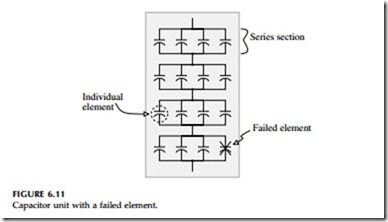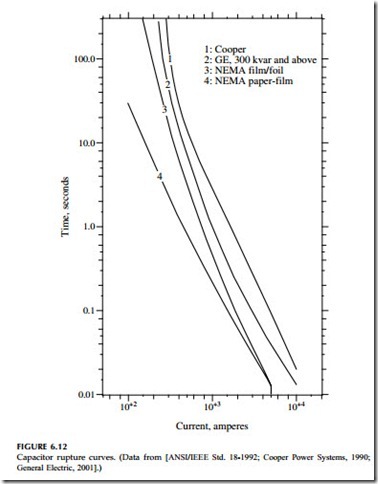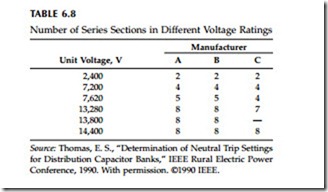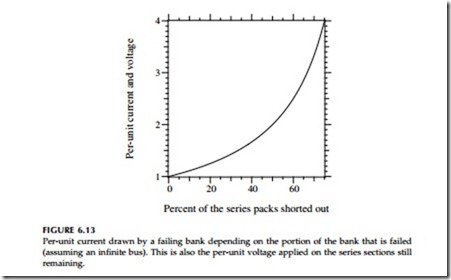Failure Modes and Case Ruptures
Capacitors can fail in two modes:
• Low current, progressive failure — The dielectric fails in one of the elements within the capacitor (see Figure 6.11). With one element shorted, the remaining elements in the series string have increased voltage and higher current (because the total capacitive impedance is lower). With more stress, another element may short out. Failures can cascade until the whole string shorts out. In this scenario, the current builds up slowly as elements successively fail.
• High current — A low-impedance failure develops across the capac- itor terminals or from a phase terminal to ground. A broken connec- tor could cause such a fault.
Most failures are progressive. Sudden jumps to high current are rare. To detect progressive failures quickly, fusing must be very sensitive. Film-foil capacitors have few case ruptures — much less than older paper units. An EPRI survey of utilities (EPRI 1001691, 2002) found that film-foil capacitor ruptures were rare to nonexistent. This contrasts sharply with paper capac- itors, where Newcomb (1980) reported that film/paper capacitors ruptured in 25% of failures.
Paper and paper-film capacitors have an insulating layer of paper between sheets of foil. When a breakdown in a pack occurs, the arc burns the paper and generates gas. In progressive failures, even though the current is only somewhat higher than normal load current, the sustained arcing can create enough gas to rupture the enclosure. Before 1975, capacitors predominantly used polychlorinated biphenyls (PCB) as the insulating liquid. Environmen- tal regulations on PCB greatly increased the costs of cleanup if these units ruptured (U.S. Environmental Protection Agency 40 CFR Part 761 Polychlo- rinated Biphenyls (PCBs) Manufacturing, Processing, Distribution in Com- merce, and Use Prohibitions). The environmental issues and safety concerns led utilities to tighten up capacitor fusing.
In modern film-foil capacitors, sheets of polypropylene film dielectric sep- arate layers of aluminum foil. When the dielectric breaks down, the heat from the arc melts the film; the film draws back; and the aluminum sheets weld together. With a solid weld, a single element can fail and not create any gas (the current is still relatively low). In film-foil capacitors, the pro- gressive failure mode is much less likely to rupture the case. When all of the packs in series fail, high current flows through the capacitor. This can gen- erate enough heat and gas to rupture the capacitor if it is not cleared quickly. Figure 6.12 shows capacitor-rupture curves from several sources. Most case-rupture curves are based on tests of prefailed capacitors. The capacitors are failed by applying excessive voltage until the whole capacitor is broken down. The failed capacitor is then subjected to a high-current short-circuit
source of known amperage for a given time. Several such samples are tested to develop a case-rupture curve.
The case-rupture curves do not represent all failure modes. Such curves do not show the performance during the most common failures: low-current and progressive element failures (before all elements are punctured). Although, thankfully, rare, high-current faults more severe than those tested for the rupture curves are possible. An arc through the insulating dielectric fluid can generate considerable pressure. Pratt et al. (1977) performed tests on film/foil capacitor units with arc lengths up to 3 in. (7.6 cm) in length. They chose 3 in. as the maximum realistic arc length in a capacitor as the gap spacing between internal series section terminals. Under these condi- tions, they damaged or ruptured several units for currents and times well below the capacitor rupture curves in Figure 6.12.
Also consider other equipment at a capacitor bank installation. Capacitor switches, especially oil switches, are vulnerable to violent failure. This type of failure has not received nearly the attention that capacitor ruptures or distribution transformer failures have. Potential transformers, current transformers, controller power-supply transformers, and arresters: these too can fail violently. Any failure in which an arc develops inside a small enclosure can rupture or explode. In areas with high fault current, consider applying current-limiting fuses. These will help protect against violent failures of capacitor units, switches, and other accessories in areas with high fault current.
When one element fails and shorts out, the other series sections have higher voltage, and they draw more current. Capacitor packs are designed with a polypropylene film layer less than one mil thick (0.001 in. or 0.025 mm), which is designed to hold a voltage of 2000 V. Table 6.8 shows the number of series sections for several capacitors as reported by Thomas (1990). More recent designs could have even fewer groups. One manufacturer uses three series sections for 7.2 to 7.96 kV units and six series sections for 12.47 to 14.4 kV units. As series sections fail, the remaining elements must hold increasing voltage, and the capacitor draws more current in the same proportion. Figure
Per-unit current drawn by a failing bank depending on the portion of the bank that is failed (assuming an infinite bus). This is also the per-unit voltage applied on the series sections still remaining.
6.13 shows the effect on the per-unit current drawn by a failing unit and the per-unit voltage on the remaining series sections.
If a capacitor bank has multiple units on one phase and all units are protected by one fuse (group fusing), the total bank current should be con- sidered. Consider a bank with two capacitor units. If one unit loses half of its series sections, that unit will draw twice its nominal current. The group — the two units together — will draw 1.5 times the nominal bank load. (This is the current that the fuse sees.)



